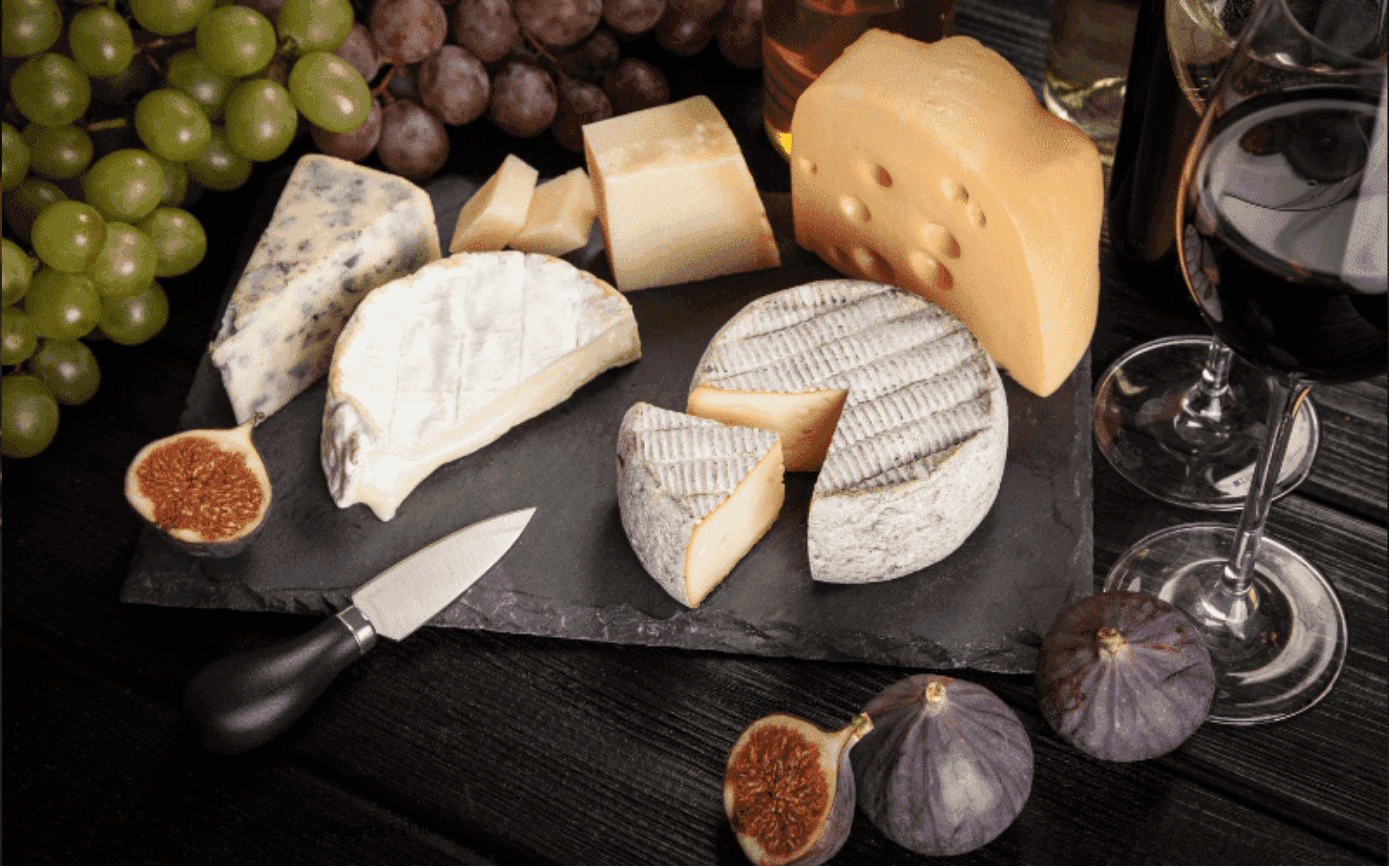By using our website, you agree to the use of cookies as described in our Cookie Policy
What is Tilsiter Cheese and How to Eat It?

If you've been following our cheese adventures, you've likely encountered Tilsiter before. We’ve defined what is Tilsit cheese, explored its history, and described its distinctive flavor profile.
Now, we’re ready to discover the many ways to enjoy this versatile semi-hard cheese. Whether you're a seasoned cheeseboard curator or an adventurous home cook, Tilsiter promises a world of taste bud-tempting experiences.
What Makes Tilsiter Unique?
Before we get into the delicious ways to enjoy Tilsiter, let's look at the qualities that set this cheese apart:
Dual Heritage
While Tilsiter traces its origins to the picturesque landscapes of Switzerland, its story is incomplete without the significant influence of Germany. Both nations have played a role in shaping the unique character of this semi-hard cheese, making it a true testament to cross-cultural culinary exchange.
Spectrum of Flavor
Tilsiter's flavor profile offers a trio of options to cater to varying preferences:
- Green Label: This pasteurized variant offers a mild and approachable introduction to Tilsiter.
- Red Label: Unpasteurized and more assertive, the red label variety often draws comparisons to a milder Limburger, with a bit more complexity.
- Yellow Label: Pasteurized with the addition of cream, this Tilsiter delivers a luxuriously mild and creamy taste experience.
Tilsiter's diverse range of labels offers a flavor spectrum for every palate, from the gentle green to the bolder yellow. Find your perfect match, whether you crave subtle spice or a more pronounced taste.
Cow’s Milk Transformation
What is Tilsit cheese at its core? It is a celebration of cow's milk. Crafted exclusively from this dairy staple, it showcases the rich, creamy essence that skilled cheesemakers expertly transform into a semi-hard delicacy.
Colorful Rind
The rind of Tilsiter is more than just an outer layer. Its vibrant hues, ranging from sunny yellow to deep red, offer visual clues to the flavor nuances within. This colorful exterior serves as an invitation to discover the taste of adventure that awaits.
Textural Range
Slicing into Tilsiter reveals a smooth and elastic texture, creating a delightful mouthfeel. Certain varieties even feature small, irregular holes, adding an element of visual intrigue to each bite. This unique texture contributes to Tilsiter's remarkable versatility in culinary applications.
How to Eat Tilsiter Cheese
So what is Tilsit cheese best enjoyed with? Thanks to its versatility, there’s an entire world of flavor possibilities to explore. Let's look at some delicious ideas to incorporate this semi-hard cheese into your culinary repertoire:
On a Cheese Board
Tilsiter's unique flavor profile shines on a cheeseboard, where it complements a variety of accompaniments:
Pairing Suggestions
- Fruits: Grapes, pears, and apples offer a refreshing counterpoint to Tilsiter's richness.
- Nuts: Walnuts and almonds add a satisfying crunch and subtle nuttiness.
- Bread: Hearty rye or tangy sourdough bread provides a sturdy base for Tilsiter's flavors.
- Crackers: Choose neutral-flavored crackers to let the cheese take center stage.
- Mustards: Honey mustard or Dijon mustard offer a piquant contrast to Tilsiter's creamy texture.
Presentation Tips
- Cutting: Cut Tilsiter into thin slices or cubes for easy snacking.
- Arranging: Create an aesthetically pleasing cheeseboard by arranging Tilsiter alongside complementary elements like fruits, nuts, and crackers.
- Garnishing: Add a sprig of rosemary or thyme for a touch of visual appeal and aroma.
Melted Goodness
Tilsiter's unique composition makes it a prime candidate for melting, paving the way to a world of ooey-gooey possibilities:
Best Melted Uses
- Sandwiches: Elevate your grilled cheese, add a gourmet touch to your Reuben, or create the ultimate panini with melted Tilsiter.
- Burgers: Top your burger with a generous slice of Tilsiter for a burst of savory flavor.
- Fondue: Indulge in the communal joy of Fondue, where Tilsiter's meltability shines.
- Gratins and Casseroles: Transform ordinary dishes into extraordinary creations with a layer of melted Tilsiter.
Why Tilsiter Melts So Well
What is Tilsit cheese celebrated for? While its flavor and aroma are distinctive, its exceptional melting quality truly sets it apart.
Tilsit’s relatively high fat content and elastic protein structure contribute to a smooth, even melt. When heated, the fat emulsifies with the cheese's moisture, resulting in a velvety texture that seamlessly incorporates into various dishes. This quality allows Tilsiter to elevate both simple and complex recipes with its luscious, melted goodness.
Cooking with Tilsiter
Tilsiter's culinary potential extends far beyond simple snacks and appetizers. Its unique flavor profile and remarkable melting properties make it a versatile ingredient that can elevate a wide array of dishes.
Tilsiter-Inspired Dishes
Consider these inspiring examples to ignite your culinary creativity further:
- Mac and Cheese: Replace traditional cheddar with Tilsiter for a mac and cheese that boasts a nuanced nuttiness and an irresistibly creamy texture.
- Savory Tilsiter Quiche: Tilsiter's rich flavor profile adds depth and complexity to a classic quiche, complementing a variety of seasonal vegetables and herbs.
- Tilsiter-Stuffed Chicken Breasts: Elevate your poultry game by stuffing chicken breasts with a luscious Tilsiter filling, resulting in a moist, flavorful, and visually appealing main course.
- Tilsiter Pasta Sauce: Transform ordinary pasta into a gourmet experience with a creamy Tilsiter sauce that coats each strand in velvety richness.
- Gourmet Tilsiter Mashed Potatoes: Incorporating Tilsiter elevates a humble side dish into a culinary masterpiece. Its melty texture and savory notes create a luxurious twist on classic mashed potatoes.
Tilsiter Tips and Recommendations
Maximizing your experience involves more than delicious recipes and knowing where to buy Tilsit cheese. A few simple tips can help you store, serve, and pair this cheese to perfection:
Storing Tilsiter
Proper storage is essential to maintaining Tilsiter's optimal flavor and texture. Wrap it tightly in wax or parchment paper to prevent it from drying out or absorbing unwanted odors. Store it in the refrigerator's cheese drawer or a cool, dark place.
Serving Temperature
For the full flavor experience, allow Tilsiter to reach room temperature before serving. This allows the fats to soften and the aromas to develop fully.
Pairings Beyond the Ordinary
Tilsiter's versatility shines through in its pairing potential. It goes beyond the traditional accompaniments and complements a variety of beverages and other cheeses:
- Beer: Lager, pilsner, and amber ale, with their malty and slightly sweet notes, pair exceptionally well with Tilsiter's savory character.
- Wine: Riesling's acidity and Gewürztraminer's aromatic notes offer a delightful contrast to Tilsiter. For red wine lovers, Pinot Noir's earthy undertones create a harmonious pairing.
- Other Cheeses: Expand your cheeseboard horizons by pairing Tilsiter with other Swiss favorites like Appenzeller or the nutty Gruyère.
Key Takeaways: What is Tilsiter Cheese and How to Eat It
By now, your question of "What is Tilsit cheese?" should be more than answered.
Whether you're a cheese enthusiast or a curious newcomer, Tilsiter promises a flavorful adventure. Its rich history, diverse flavor profile, and culinary versatility make it a cheese worth exploring. We invite you to go on your own Tilsiter journey – experiment with pairings, try new recipes, and discover the endless possibilities this remarkable cheese offers.
For an exquisite selection of Tilsiter and other fine cheeses, visit our website and give your next culinary creation a boost. Your taste buds will thank you.
‹ Back








